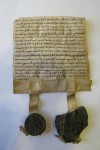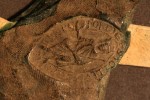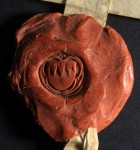 A new study will apply modern forensic crime solving techniques to the Middle Ages by examining the hand and fingerprints left on wax seals from the 12th to 14th centuries. The three-year research project will collect the prints left on seals attached to a variety of documents in the collections of Exeter, Hereford and Lincoln cathedrals, Westminster Abbey and the National Library of Wales. Project leaders Professor Philippa Hoskin from the University of Lincoln and Dr. Elizabeth New from Aberystwyth University will explore what the prints call tell us about authority, bureaucracy, authentication and the law in medieval England and Wales.
A new study will apply modern forensic crime solving techniques to the Middle Ages by examining the hand and fingerprints left on wax seals from the 12th to 14th centuries. The three-year research project will collect the prints left on seals attached to a variety of documents in the collections of Exeter, Hereford and Lincoln cathedrals, Westminster Abbey and the National Library of Wales. Project leaders Professor Philippa Hoskin from the University of Lincoln and Dr. Elizabeth New from Aberystwyth University will explore what the prints call tell us about authority, bureaucracy, authentication and the law in medieval England and Wales.
 The prints will also literally be run through AFIS, comparing fingerprints that are at least 700 years old to modern ones. Researchers are looking for any close or approximate matches even over centuries. Any such discoveries will contribute significantly the study of print identification, which isn’t as well-established, scientifically speaking, as some TV programs would have you believe. Having said that, I really hope someone films Professor Hoskin or Dr. New looking at a fingerprint on a wax seal and saying “Let’s run it through AFIS.”
The prints will also literally be run through AFIS, comparing fingerprints that are at least 700 years old to modern ones. Researchers are looking for any close or approximate matches even over centuries. Any such discoveries will contribute significantly the study of print identification, which isn’t as well-established, scientifically speaking, as some TV programs would have you believe. Having said that, I really hope someone films Professor Hoskin or Dr. New looking at a fingerprint on a wax seal and saying “Let’s run it through AFIS.”
 Because many of the seals are found on financial documents — property sales, business contracts, assorted transactions — there’s even a chance the study will veer from CSI into Cold Case as the fingerprint comparisons might detect 900-year-old fraud or forgery.
Because many of the seals are found on financial documents — property sales, business contracts, assorted transactions — there’s even a chance the study will veer from CSI into Cold Case as the fingerprint comparisons might detect 900-year-old fraud or forgery.
Wax seals were ubiquitous by the 12th century, used as a secure mark of the owner’s agreement the way a valid signature is
 today on any legal document. Administrative documents of any kind required seals to be validated. Despite their legal significance when the seals were first pressed into wax, the seals themselves have rarely been studied. Historians tend to focus on the documents, not the dangly bits, except insofar as they hold identifying information regarding the parties to the documents. The Imprint study is breaking new ground.
today on any legal document. Administrative documents of any kind required seals to be validated. Despite their legal significance when the seals were first pressed into wax, the seals themselves have rarely been studied. Historians tend to focus on the documents, not the dangly bits, except insofar as they hold identifying information regarding the parties to the documents. The Imprint study is breaking new ground.
Dr Elizabeth New, Senior Lecturer in Medieval History at Aberystwyth University, comments that: “Hand prints on wax seals bring us close to medieval people in a very tangible way. It is important to remember that seals were not just the preserve of kings and great nobles: men and women from all levels of society also set their seals on documents.
“Medieval seals contained a variety of images and words, providing strong statements of identity and very valuable sources of information about people, culture and society. The images can tell us what things actually looked like, and provide glimpses of humour, piety and family pride. They also enabled otherwise illiterate men and women the means to ‘write’ their name.
“These small objects have always had great significance, and are rich time-capsules that can open exciting windows into past lives. Examining the hand prints left – both accidentally and deliberately – in the wax along with impressions of seal matrices provides further important opportunities to deepen our understanding of our medieval ancestors.”
All the prints collected will be entered into an online database along with information about the documents and the seals the prints were taken from. That archive will be made accessible to researchers and the general public.